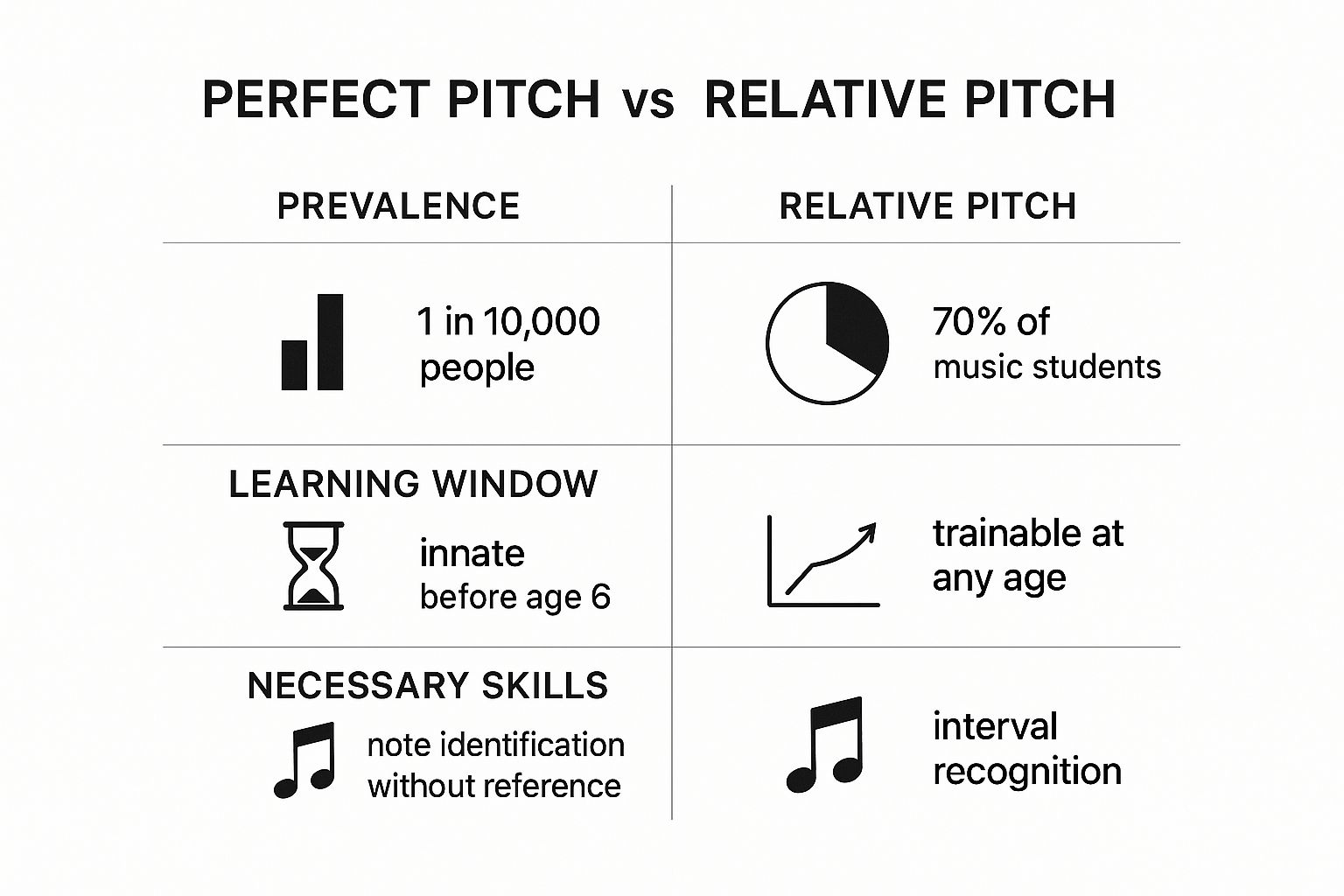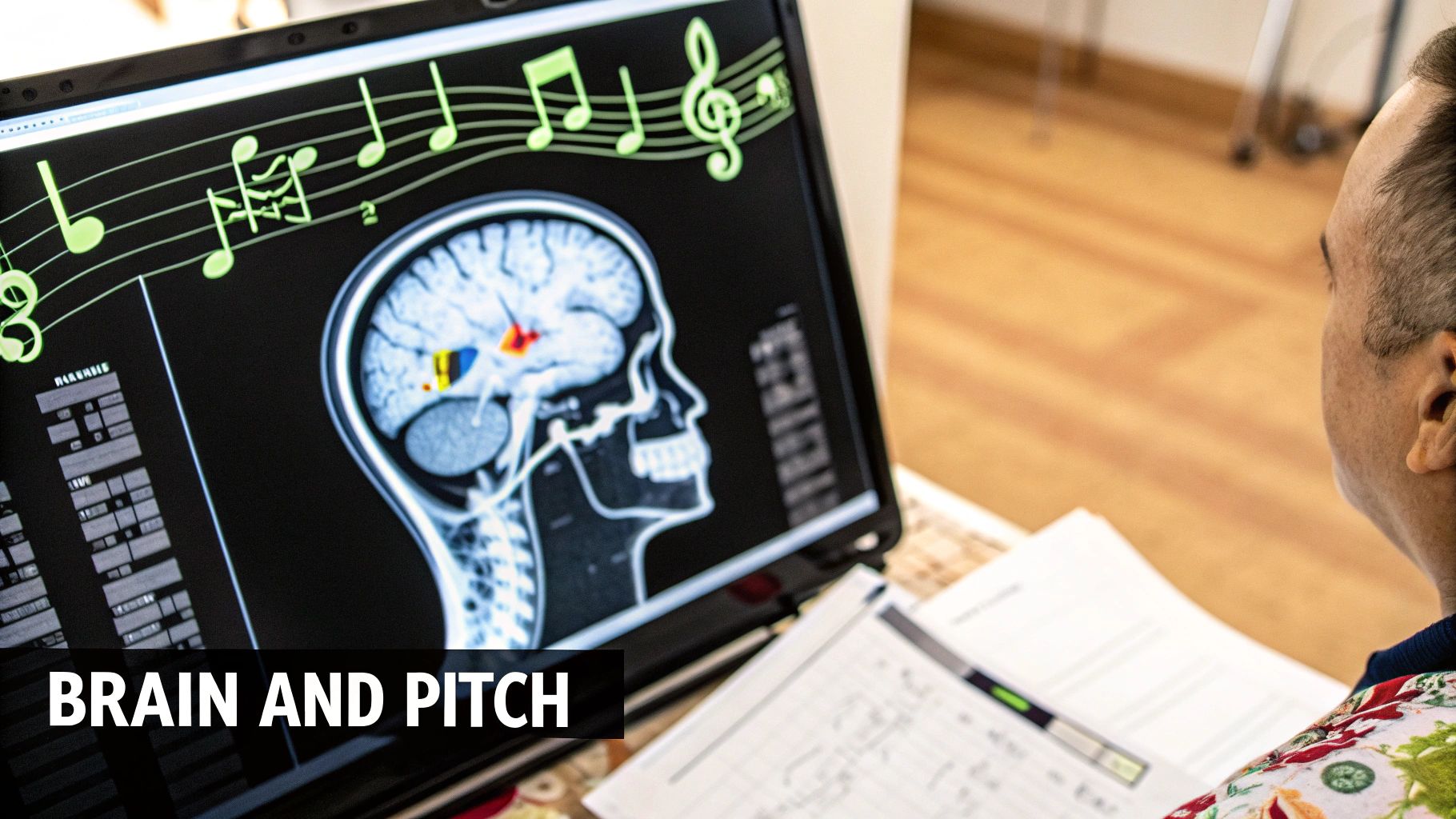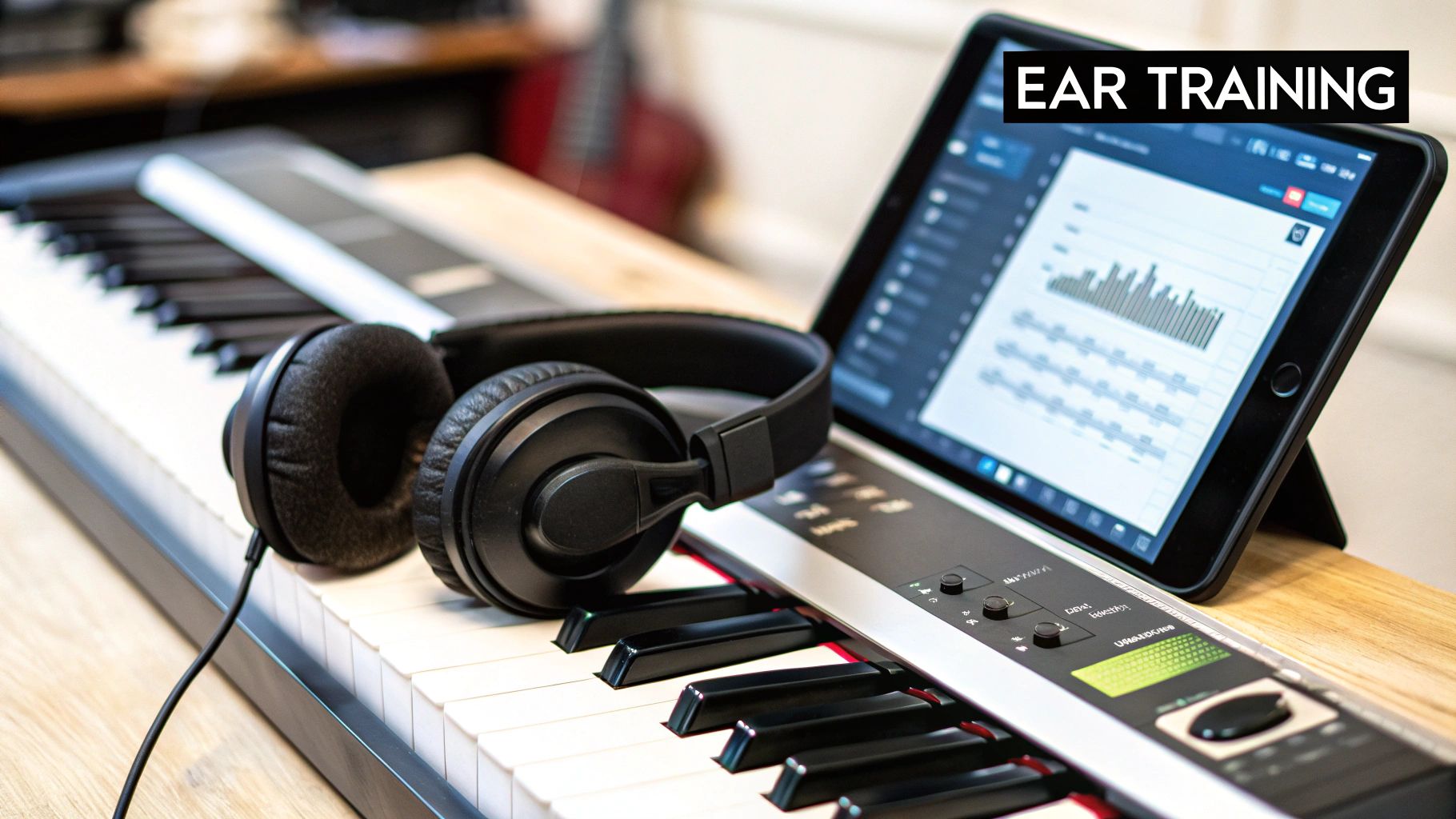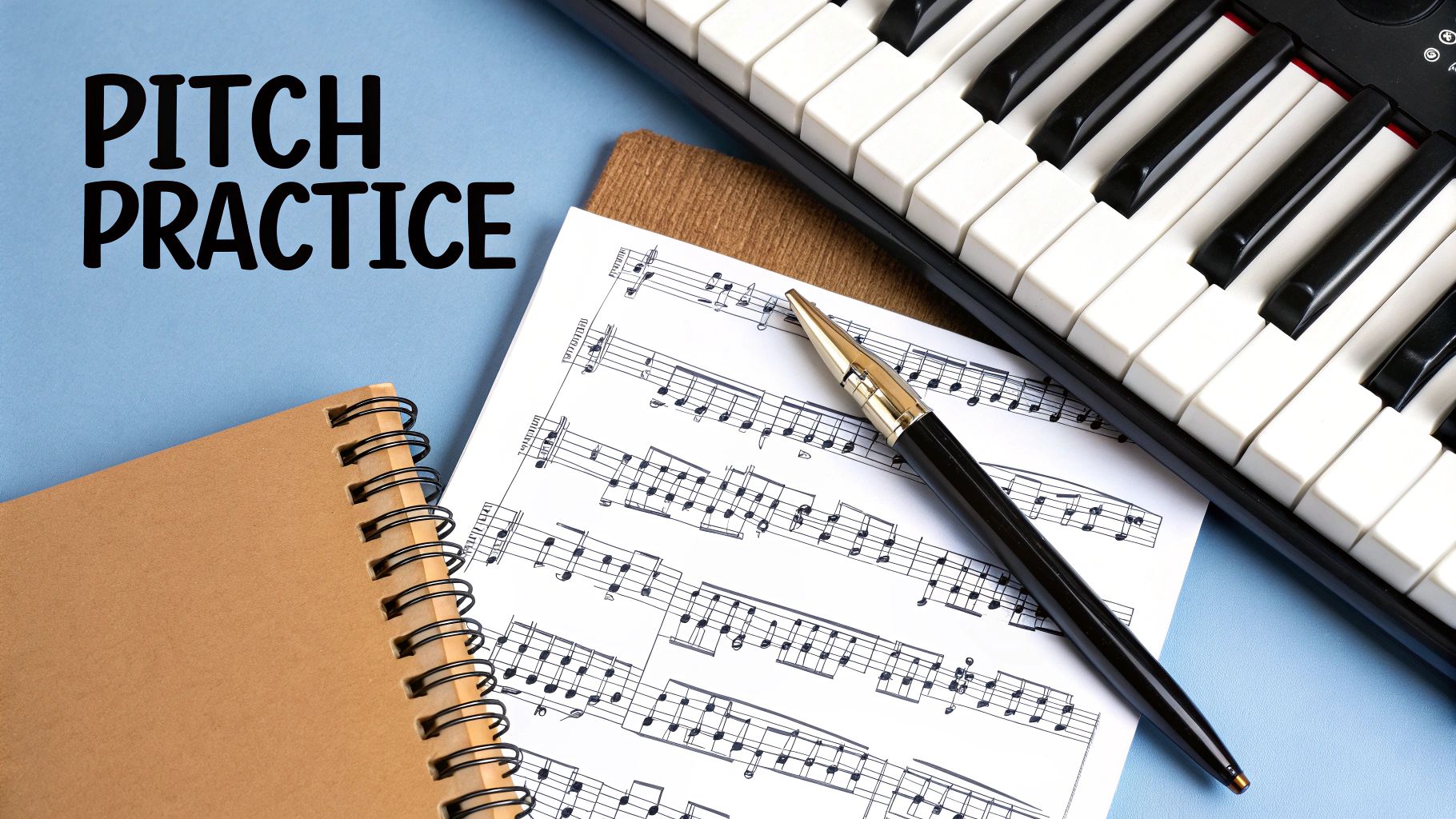Can You Learn Perfect Pitch? Discover the Truth Today
Wondering can you learn perfect pitch? Explore the science, adult training tips, and how relative pitch plays a role.
Posted by
Joe BrewerRelated reading
Unlock Music Theory Fundamentals Today
Your journey to understanding music starts here. Our guide makes music theory fundamentals easy, with clear explanations on scales, chords, rhythm, and more.
How to Hear Chord Changes Like a Pro Musician in 60 Seconds
Learn how to hear chord changes easily with our expert tips. Improve your musical ear today and master listening skills like a professional!
A Practical Guide on How to Sing in Tune
Struggling with pitch? Learn how to sing in tune with proven exercises, ear training, and pro tips to finally build your vocal confidence and accuracy.
Can You Learn Perfect Pitch? Discover the Truth Today
So, can you actually learn perfect pitch? The honest answer is a bit complicated. While some people seem to be born with it, science points to a much more interesting reality.
For most adults, developing true, effortless perfect pitch is incredibly challenging. That said, improving your pitch recognition to a very high degree is absolutely achievable. It's not a simple 'yes' or 'no'—it helps to think of pitch ability as a spectrum.
The Truth About Learning Perfect Pitch
Perfect pitch, also known as absolute pitch, is like having a built-in musical compass. It’s the rare ability to identify a note—an F# or a B-flat, for example—the moment you hear it, with no reference point.
Imagine seeing the color blue and just knowing it's blue without having to compare it to anything else. In music, this means hearing a random car horn and instantly recognizing, "Hey, that's a G." For a long time, everyone just assumed this was a rare, innate gift. But modern research tells a story that blends genetics with early childhood exposure and focused training. It’s not just what you’re born with; it's also about what you're exposed to.
The Rarity of Perfect Pitch
You’ve probably heard the statistic that only 1 in 10,000 people has perfect pitch. But newer research suggests that figure might be a bit low, especially when you look at people with musical training. A 2019 review, for example, found that at least 4% of music students have perfect pitch. This strongly suggests that consistent musical training, particularly early on, can play a huge role. You can dive deeper into these findings in this UChicago perfect pitch explainer.
To really get why learning it is so tough, it's useful to compare it to a related and far more common skill: relative pitch.
Perfect Pitch vs Relative Pitch At a Glance
Let's break down the key differences between these two auditory skills. While they both involve identifying notes, how they work is fundamentally different.
| Attribute | Perfect Pitch (Absolute Pitch) | Relative Pitch |
|---|---|---|
| Core Skill | Instantly identifies a note without context. | Identifies a note by comparing it to another reference note. |
| How It Feels | Hearing a "C" is like seeing the color "red"—it's an immediate, direct quality. | Hearing a "C" then a "G" and knowing the distance is a perfect fifth. |
| Prevalence | Very rare, estimated at 1 in 10,000, but higher in musicians. | Very common; a foundational skill for almost all musicians. |
| Learnability | Extremely difficult to learn after early childhood (around age 7). | Highly trainable and can be mastered at any age with practice. |
| Dependency | Independent of context. | Entirely dependent on having a reference note to start from. |
The takeaway here is that while perfect pitch is often linked to a critical window in early development, relative pitch is a skill anyone can build through practice. This distinction is vital because it helps frame what’s realistic for most of us who want to improve our ear.

The ability to develop perfect pitch seems to be a mix of genetic predisposition and, crucially, early exposure to music. But don't let that discourage you. The journey to a better musical ear is far from over, even if true perfect pitch remains elusive.
How Your Brain Learns to Recognize Pitch

When we talk about perfect pitch, we almost always land on the classic "nature versus nurture" debate. Is it something you're born with, or something you learn? While some people might have a genetic leg up, the science points to our environment being a powerful trigger, especially during what’s known as the "critical window."
Imagine your brain in early childhood is like a block of wet cement. Before the age of six, its pathways for processing sound are incredibly pliable. If you're consistently exposed to musical notes during this time, your brain can literally form hardwired connections for specific pitches. The impression becomes permanent, long after that cement has set.
The question of whether you can truly learn perfect pitch seems to come down to a mix of innate potential and early environmental influence. For instance, starting music lessons before age six is known to significantly boost the chances of developing it. You can find more details on how early exposure sculpts our hearing abilities on Audionova.com.
This remarkable ability for the brain to reshape itself is called neural plasticity. Early auditory experiences don't just teach you about music; they physically build the brain that perceives it.
The Surprising Link Between Language and Pitch
Some of the most compelling evidence for the "nurture" side of the argument comes from a rather unexpected place: tonal languages. In languages like Mandarin or Vietnamese, the pitch at which a word is spoken completely changes its definition.
Take the syllable "ma" in Mandarin, for example. Depending on the tone you use, it can mean "mother," "hemp," "horse," or even a scolding remark. From the moment they're born, children learning these languages are essentially getting ear training, conditioning them to link absolute pitches with distinct meanings.
So, what does this tell us about learning perfect pitch?
- Daily Practice: Speakers of tonal languages receive constant, real-world ear training just by having conversations.
- Higher Prevalence: Unsurprisingly, these individuals have a much higher incidence of perfect pitch than people who speak non-tonal languages like English.
This connection strongly suggests that the brain can be trained to recognize absolute pitches, provided the training is intensive, meaningful, and starts at a very young age. Our early soundscape quite literally builds the foundation for our musical mind.
Uncovering Your Hidden Pitch Potential
So, is perfect pitch one of those rare gifts you're either born with or you're not? For a long time, that's what we thought. But the latest science is painting a much more interesting picture. It turns out, this rigid, black-and-white view is giving way to the idea that pitch perception is actually a spectrum—and many of us might have a hidden talent just waiting to be discovered.
Instead of asking, "Can you learn perfect pitch?" maybe a better question is, "How can I awaken the pitch ability I already have?" The foundation for this skill might just be lying dormant.
You Might Already Have It
This isn't just wishful thinking; there's some fascinating research to back it up. A 2017 study from the University of Arizona found something remarkable: even people with zero musical training have a subconscious knack for absolute pitch. They might not be able to name a 'C#' out of thin air, but their brains can tell when a familiar song is played in its original key versus a new, transposed one.
This finding completely changes the conversation. It suggests that many of us possess a partial or latent form of perfect pitch without ever realizing it. The ability isn't just for a select few; it’s a more widespread human trait than we once thought.
This means you’re probably not starting from absolute zero. Instead, you're building on an intuitive sense that's already wired into your brain. You can dig into the specifics of how this hidden pitch ability is more common than previously believed in the published research.
The goal, then, isn't about creating a skill from scratch. It's about strengthening an existing one and bringing it to the surface. Think of it like discovering you've always had the muscles to be a great swimmer—you just need the right coaching to learn the strokes and activate them.
Realistic Training Methods for Improving Pitch

While experts still debate whether adults can truly develop perfect pitch, one thing is certain: you can absolutely get much, much better at recognizing pitches. This isn't about theory anymore; it's about putting in the work. So, forget any ideas about overnight success. This is a marathon, not a sprint, and it's built on small, consistent habits.
The real goal isn't to magically wake up with Mozart's ears. It's about systematically training your brain to forge a stronger link between a sound and its name. Your two best friends on this journey? Patience and consistency.
Start with a Single Reference Note
The most trusted and effective training method begins with a single anchor. Don't try to learn all twelve notes at once—that's a recipe for frustration. The whole process starts by internalizing just one pitch until you know it instinctively.
For most people, the go-to starting point is 'A' 440 Hz, the standard tuning note for orchestras. Your first job is to make this single note your musical home base.
Think of it like learning your way around a new city by first memorizing one major landmark. Once you can find that landmark from anywhere, you can start navigating to all the streets around it. Your reference note works the exact same way on your musical map.
To do this, you need to listen to your chosen note multiple times every single day. Use a tuning fork, a digital tuner, or a piano. Hum it back. Sing it. Try to conjure it up from memory while you're making coffee or waiting for the bus, without listening to the reference. The key is high-frequency, low-intensity practice.
Building Your Pitch Library
Once your anchor note is rock-solid, you can start expanding. But don't rush it. Only when you can pick out your first note with confidence should you add a second one, like 'C'.
- Practice with Purpose: Use ear training apps that give you instant feedback. Many are gamified, which helps turn what could be a chore into something fun.
- Create Associations: Try linking pitches to memorable, real-world sounds. Maybe a low 'C' reminds you of a foghorn, or a high 'G' sounds just like a specific bird you hear every morning.
- Test Yourself Blindly: This is crucial. Ask a friend to play random notes for you on a piano, or use an app's testing feature to check your recall without any visual hints.
This slow-and-steady approach—mastering one note, then adding another—is the most reliable way to build a mental library of pitches. It’s a gradual journey, but it’s one that turns the abstract goal of "better pitch" into a concrete, achievable reality.
Why Relative Pitch Is Your Real Musical Superpower
While the idea of having perfect pitch is definitely cool, it's easy to miss the skill that actually powers day-to-day musicianship: relative pitch. This is the unsung hero for countless musicians, and the best part is that anyone can learn it. It’s not about naming a note in a vacuum; it’s about understanding how notes relate to each other.
Let’s put it this way: perfect pitch is like having a built-in GPS that can pinpoint your exact coordinates at any moment. Relative pitch, on the other hand, is like having an incredible sense of direction. Once you have a starting point—a reference note—you can confidently find your way anywhere else on the musical map.
This is the skill that does the heavy lifting in almost all real-world musical situations. It’s what lets a guitarist tune their instrument by ear, using just one string as a guide. It's the magic that allows a singer to hear a melody and instantly craft a beautiful harmony line to accompany it.
The True Foundation of Musicianship
Honestly, developing your relative pitch is one of the most powerful things you can do for your musical growth. It’s the key that unlocks a much deeper, more intuitive understanding of how music works. As you sharpen this skill, you start to hear music less like a random string of sounds and more like a language built from intervals, chords, and progressions.
Relative pitch is the ability to identify a note by comparing it to another note you’ve just heard. If someone plays a C and then a G, you recognize that distance as a “perfect fifth.” It’s a completely trainable skill that forms the core of ear training for any serious musician.
A composer with a great ear, for instance, can listen to a complex symphony and write down the score. They aren't naming every single note out of thin air; they're identifying each one based on its relationship to the notes that came just before it. This practical, powerful ability is far more crucial for making music than being able to name a car horn's pitch.
We see these skills play out in different ways depending on the task at hand. Let's look at a few common scenarios to see how each type of pitch recognition really shines.
Practical Applications of Pitch Skills
| Musical Task | Utility of Perfect Pitch | Utility of Relative Pitch |
|---|---|---|
| Tuning an Instrument | Instantly knows if a string is flat or sharp without a reference. | Hears the interval between strings and adjusts them to be in tune with each other. |
| Transcribing a Song | Can identify the key of the song instantly and name individual notes quickly. | Figures out the first note, then uses intervals to map out the rest of the melody and chords. |
| Improvising a Solo | Knows the exact notes being played by the band, helping to choose notes that fit. | Hears the chord progression and intuitively knows which scales and notes will sound good over it. |
| Singing a Harmony | Can hear a melody and immediately sing a specific harmony note (e.g., a major third above). | Hears the main melody and finds a harmony that sounds right by feeling the interval distance. |
At the end of the day, a strong sense of relative pitch is what separates good musicians from great ones.
While the quest for perfect pitch is an interesting one, your journey to becoming a confident, well-rounded musician is paved with developing your relative pitch. It’s the learnable, dependable skill that will empower you to play by ear, improvise freely, and truly connect with the music you create and love.
Frequently Asked Questions About Pitch Training
 As you start exploring the world of pitch training, it's totally normal for some questions to come up. Let's tackle some of the most common ones I hear from aspiring musicians.
As you start exploring the world of pitch training, it's totally normal for some questions to come up. Let's tackle some of the most common ones I hear from aspiring musicians.
How Long Does It Take an Adult to Learn Perfect Pitch?
This is the big question, but unfortunately, there’s no magic number. An adult’s journey to mastering pitch recognition really depends on their natural aptitude and, most importantly, how consistently they practice.
If you're starting from zero, getting to a high level of pitch memory could take several years of dedicated daily training. It's less about gaining true, instantaneous perfect pitch and more about building an incredibly solid and reliable memory for notes. Think of it as a long-term project where you measure progress in months and years, not days.
The path to better pitch recognition is a marathon, not a sprint. Your success comes down to patience and sustained effort, and everyone's results will look a little different. It's all about gradual improvement, not some overnight miracle.
Are There Any Downsides to Having Perfect Pitch?
Believe it or not, yes. For some musicians, perfect pitch can be a bit of a double-edged sword. If an instrument is even slightly out of tune, a performance can sound physically grating or just plain wrong to them.
Transposing music can also be a real headache. Their brain is wired to hear the absolute notes (C, F#, etc.), not just the relationships between them. A familiar melody played in a new key can sound like a completely different song. To someone with perfect pitch, a tune in C Major is fundamentally not the same piece as that same tune in D Major, which can make it tough to adapt on the fly.
Is Learning Relative Pitch Easier Than Perfect Pitch?
Absolutely, and by a long shot. Relative pitch is a foundational skill that’s taught in almost every music education program for a reason: nearly anyone can learn it with practice.
While it still takes work, the brain is much better at learning relational hearing as an adult. It's far more flexible than trying to create the rigid neural connections required for absolute pitch later in life.